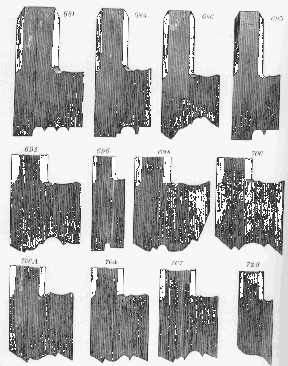
Cataloguing Tools and Implements

Access Points

The collection is searchable by:

- Information about manufacture
- Corporate manufacturer name
- Designer name
- Place of manufacture
- Date of manufacture
- Model number.
- Patent number
- Title, derived from all kinds of secondary literature, especially
sales catalogues. It has been the cataloguers' policy
to be very generous with the inclusion of alternative titles, whether
they be common names, generic names, brand names, or
descriptive names taken from trade literature. Complex
specific names are broken down and entered under both
the entire name and the parts, so that someone
looking for pipe wrenches will find them, whether
or not he or she know enough to look for the
"Donahue," "Guthrie," or "Barwick" pipe wrenches
in the collection. The most specific name has been
preferred as the main title, and most entries use
title as the main entry.
- Brand name ("Super Grip")
- Common name ("Crescent wrench")
- Generic name ("Offset adjustable wrench")
- Generic name ("Adjustable wrench")
- Generic name ("Mechanic's wrench")
- Type of... ("Wrench")
- Kits are similarly given entries at the
collective level as well as being given analytical
entries devoted to each component.

- Use information. Search by
- Trade or craft in which the tool is employed. If it is
employed in several, put them all in. Enter the tool under
each level of the hierarchy. E.g.:
- Task which the tool performs, if definable ("amputation" "rabbeting" "ear-piercing")
- Manner of operation ("boring," "slicing" etc. using controlled vocabulary)
- Material and objects addressed (when definable)
- Provenance of item in hand (former owners, etc.)
- When the catalogue is operational, all such
"manner," "object," "task," and "trade" fields
should serve as hot links, facilitating movement
within the catalogue. Finding a single farrier's
tool should reveal "farrier" as a value in the
craft field; clicking on "farrier" should generate
a list of all other tools in the collection that were
used by farriers; clicking on "splitting," found
under the entry for a wedge, should generate a
list that includes mauls and froes. (The same
search engine is employed
as in an ordinary search, of course, but its operation
is in this case invisible to the user.)

- The physical description, title, and subject are
not entirely distinguishable in a tool or implement, since form and material
determine function ("subject") and specific title; and function determines general
title. Some quantifiable or readily controllable aspects of the physical
description that might serve as good access points include:
- The more difficult aspects of physical description to make accessible
are those that require visual indexing, and that not merely by photograph
but often by drawing: search by shape. For example, to search
for a wooden plane with a particularly shaped blade, one either has to
know the name of the pattern (in which case the search can be conducted
by some level of title), or know the shape of the pattern, in which case
one needs to be able to search visually.

Some Plane blades
Another example is drawing knives.

Some Drawing Knives
Only a visual index will allow someone looking
for a mate to his or her tool to identify what it
is. As you can see, most of these drawing knives
are virtually identical even when shown this way.
Often a more detailed examination, and therefore
a more detailed visual index, is required to
answer the question, "show me a tool like this one."
The technical implementation of this feature
has proven quite difficult.

Cross-sections of different kinds of
drawing knives
Even when the general category is pretty evident,
a visual index can help, e.g. with pipe
wrenches, of which there are many many varieties,
a few of them illustrated here:

Varieties of Pipe Wrench
From which a link to an actual item or other information
is easy:
Always Ready Wrench

Stillson's Wrench

Coe's-pattern Wrench










































